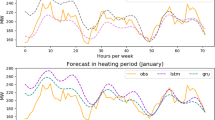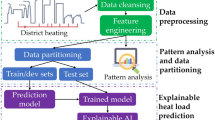Abstract
Accurate heat load prediction is essential for heat production and refined management of district heating systems (DHSs). More advanced technology can often achieve more accurate forecasts. This paper suggests using temporal convolutional network (TCN) and categorical boosting (CatBoost) for heat load prediction. To test the performance of TCN and CatBoost in heat load prediction missions, two additional benchmark models, the decision tree model (DT) and the statistically based multiple linear regression (MLR), are built for comparison. A DHS in Tianjin, China, is used as the study case. Two historical operational characters (day-ahead heat load and hour-ahead heat load) and four meteorological characters (outdoor temperature, relative humidity, wind scale, and air quality index) are selected as input features for the models. The prediction results of every model on the test set are displayed and discussed. The experimental findings indicate that the prediction results of TCN and CatBoost are more accurate than the traditional prediction models, while the modeling process of CatBoost is simpler. Overall, TCN and CatBoost are potential heat load prediction methods.





Similar content being viewed by others
REFERENCES
Y. M. Li, J. J. Xia, H. Fang, Y. B. Su, and Y. Jiang, “Case study on industrial surplus heat of steel plants for district heating in Northern China,” Energy 102, 397–405 (2016). https://doi.org/10.1016/j.energy.2016.02.105
W. Xiong, Y. Wang, B. V. Mathiesen, H. Lund, and X. Zhang, “Heat roadmap China: New heat strategy to reduce energy consumption towards 2030,” Energy 81, 274–285 (2015). https://doi.org/10.1016/j.energy.2014.12.039
H. Lund, N. Duic, P. A. Østergaard, and B. V. Mathiesen, “Smart energy systems and 4th generation district heating,” Energy 110, 1–4 (2016). https://doi.org/10.1016/j.energy.2016.07.105
H. Lund, P. A. Ostergaard, M. Chang, S. Werner, S. Svendsen, P. Sorknaes, J. E. Thorsen, F. Hvelplund, B. O. G. Mortensen, B. V. Mathiesen, C. Bojesen, N. Duic, X. L. Zhang, and B. Moller, “The status of 4th generation district heating: Research and results,” Energy 164, 147–159 (2018). https://doi.org/10.1016/j.energy.2018.08.206
X. W. Li and J. Wen, “Review of building energy modeling for control and operation,” Renewable Sustainable Energy Rev. 37, 517–537 (2014). https://doi.org/10.1016/j.rser.2014.05.056
J. L. Cao, J. Liu, and X. X. Man, “A united WRF/TRNSYS method for estimating the heating/cooling load for the thousand-meter scale megatall buildings,” Appl. Therm. Eng. 114, 196–210 (2017). https://doi.org/10.1016/j.applthermaleng.2016.11.195
S. Idowu, S. Saguna, C. Åhlund, and O. Schelén, “Applied machine learning: Forecasting heat load in district heating system,” Energy Build. 133, 478–488 (2016). https://doi.org/10.1016/j.enbuild.2016.09.068
S. J. Huang and K. R. Shih, “Short-term load forecasting via ARMA model identification including non-Gaussian process considerations,” IEEE Trans. Power Syst. 18, 673–679 (2003). https://doi.org/10.1109/tpwrs.2003.811010
T. T. Fang and R. Lahdelma, “Evaluation of a multiple linear regression model and SARIMA model in forecasting heat demand for district heating system,” Appl. Energy 179, 544–552 (2916). https://doi.org/10.1016/j.apenergy.2016.06.133
E. T. Al-Shammari, A. Keivani, S. Shamshirband, A. Mostafaeipour, P. L. Yee, D. Petkovic, and C. Sudheer, “Prediction of heat load in district heating systems by Support Vector Machine with Firefly searching algorithm,” Energy 95, 266–273 (2016). https://doi.org/10.1016/j.energy.2015.11.079
M. Barman, N. B. D. Choudhury, and S. Sutradhar, “A regional hybrid GOA–SVM model based on similar day approach for short-term load forecasting in Assam, India,” Energy 145, 710–720 (2018). https://doi.org/10.1016/j.energy.2017.12.156
T. Wang, T. Y. Ma, D. S. Yan, J. Song, J. S. Hu, G. Y. Zhang, and Y. H. Zhuang, “Prediction of heat load fluctuation based on fuzzy information granulation and support vector machine,” Therm. Sci. 25, 3219–3228 (2021). https://doi.org/10.2298/tsci200529307w
M. Protic, S. Shamshirband, M. H. Anisi, D. Petkovic, D. Mitic, M. Raos, M. Arif, and K. A. Alam, “Appraisal of soft computing methods for short term consumers' heat load prediction in district heating systems,” Energy 82, 697–704 (2015). https://doi.org/10.1016/j.energy.2015.01.079
D. Koschwitz, J. Frisch, and C. van Treeck, “Data-driven heating and cooling load predictions for non-residential buildings based on support vector machine regression and NARX recurrent neural network: A comparative study on district scale,” Energy 165, 134–142 (2018). https://doi.org/10.1016/j.energy.2018.09.068
Y. Lu, Z. Tian, P. Peng, J. Niu, W. Li, and H. Zhang, “GMM clustering for heating load patterns in-depth identification and prediction model accuracy improvement of district heating system,” Energy Build. 190, 49–60 (2019). https://doi.org/10.1016/j.enbuild.2019.02.014
M. B. Simonovic, V. D. Nikolic, E. P. Petrovic, and I. T. Ciric, “Heat load prediction of small district heating system using artificial neural networks,” Therm. Sci. 20, 1355–1365 (2016). https://doi.org/10.2298/TSCI16S5355S
P. N. Xue, Y. Jiang, Z. G. Zhou, X. Chen, X. M. Fang, and J. Liu, “Multi-step ahead forecasting of heat load in district heating systems using machine learning algorithms,” Energy 188, 116085 (2019). https://doi.org/10.1016/j.energy.2019.116085
Z. Q. Wei, T. W. Zhang, B. Yue, Y. X. Ding, R. Xiao, R. Z. Wang, and X. Q. Zhai, “Prediction of residential district heating load based on machine learning: A case study,” Energy 231, 120950 (2021). https://doi.org/10.1016/j.energy.2021.120950
A. Moradzadeh, B. Mohammadi-Ivatloo, M. Abapour, A. Anvari-Moghaddam, and S. S. Roy, “Heating and cooling loads forecasting for residential buildings based on hybrid machine learning applications: A comprehensive review and comparative analysis,” IEEE Access 10, 2196–2215 (2022). https://doi.org/10.1109/access.2021.3136091
D. Geysen, O. de Somer, C. Johansson, J. Brage, and D. Vanhoudt, “Operational thermal load forecasting in district heating networks using machine learning and expert advice,” Energy Build. 162, 144–153 (2018). https://doi.org/10.1016/j.enbuild.2017.12.042
M. Dahl, A. Brun, and G. B. Andresen, “Using ensemble weather predictions in district heating operation and load forecasting,” Appl. Energy 193, 455–465 (2017). https://doi.org/10.1016/j.apenergy.2017.02.066
M. J. Gong, J. Wang, Y. Bai, B. Li, and L. Zhang, “Heat load prediction of residential buildings based on discrete wavelet transform and tree-based ensemble learning,” J. Build. Eng. 32, 101455 (2020). https://doi.org/10.1016/j.jobe.2020.101455
A. T. Eseye and M. Lehtonen, “Short-term forecasting of heat demand of buildings for efficient and optimal energy management based on integrated machine learning models,” IEEE Trans. Ind. Inf. 16, 7743–7755 (2020). https://doi.org/10.1109/tii.2020.2970165
N. Izadyar, H. Ghadamian, H. C. Ong, Z. Moghadam, C. W. Tong, and S. Shamshirband, “Appraisal of the support vector machine to forecast residential heating demand for the district heating system based on the monthly overall natural gas consumption,” Energy 93, 1558–1567 (2015). https://doi.org/10.1016/j.energy.2015.10.015
D. Z. Wu, L. K. Foong, and Z. J. Lyu, “Two neural-metaheuristic techniques based on vortex search and backtracking search algorithms for predicting the heating load of residential buildings,” Eng. Comput. 38, 647–660 (2022). https://doi.org/10.1007/s00366-020-01074-z
M. Gong, H. Zhou, Q. Wang, S. Wang, and P. Yang, “District heating systems load forecasting: a deep neural networks model based on similar day approach,” Adv. Build. Energy Res. 14, 372–388 (2020). https://doi.org/10.1080/17512549.2019.1607777
J. Y. Liu, X. Wang, Y. Zhao, B. Dong, K. Lu, and R. R. Wang, “Heating load forecasting for combined heat and power plants via strand-based LSTM,” IEEE Access 8, 33360–33369 (2020). https://doi.org/10.1109/access.2020.2972303
S. Leiprecht, F. Behrens, T. Faber, and M. Finkenrath, “A comprehensive thermal load forecasting analysis based on machine learning algorithms,” Energy Rep. 7, 319–326 (2021). https://doi.org/10.1016/j.egyr.2021.08.140
S. Bai, J. Z. Kolter, and V. J. Koltun, “An empirical evaluation of generic convolutional and recurrent networks for sequence modeling” (2018). https://doi.org/10.48550/arXiv.1803.01271
L. Prokhorenkova, G. Gusev, A. Vorobev, A. V. Dorogush, and A. J. A. Gulin, “CatBoost: unbiased boosting with categorical features,” in Proc. 32nd Conf. on Advances in Neural Information Processing Systems (NeurI-PS 2018), Montreal, Canada, Dec. 3–8, 2018, Ed. by S. Bengio, H. Wallach, H. Larochelle, K. Grauman, N. Cesa-Bianchi, and R. Garnett (Curran, Red Hook, N.Y., 2019).
Author information
Authors and Affiliations
Corresponding author
Ethics declarations
The authors declare that they have no conflicts of interest.
Rights and permissions
About this article
Cite this article
Han, C., Gong, M., Sun, J. et al. Heat Load Prediction for District Heating Systems with Temporal Convolutional Network and CatBoost. Therm. Eng. 70, 719–726 (2023). https://doi.org/10.1134/S0040601523090045
Received:
Revised:
Accepted:
Published:
Issue Date:
DOI: https://doi.org/10.1134/S0040601523090045




